
3. Pepperell Manufacturing Company, Biddeford, Me., (#32413), surveyed August 17, 1945
Associated Mutual Insurance Companies , 1945

Click on image to see larger version.
The Pepperell Manufacturing Company was the brainchild of Samuel Bachelder, an engineer and textile pioneer. He first saw the falls of the Saco River in 1831 and was impressed by the power of the hurtling water. In 1837, he was able to charter the Saco Water Power Company which he modeled after the Locks and Canals Company of Lowell, Massachusetts. The economic depression of 1837 slowed progress, and it was not until June of 1839 that the company was formally organized under its charter. By 1843, the foundations were being laid for the first Cotton Mill in Biddeford. Bachelder applied to the Maine Legislature for a charter to develop an upper mill site which he eventually named after Sir William Pepperell who, over a hundred years earlier, had helped to build a small sawmill on the opposite side of the river known as Pepperell Mill. On February 16, 1844, the legislature granted the charter for the Pepperell Manufacturing Company.
The site plan and cross sections of this survey show the expansive buildings of the Pepperell Manufacturing Company in 1945. By this time, the company had absorbed two of its predecessors: the Laconia Company, which was incorporated and organized from 1841-1844, and the Saco Water Power Company. Laconia initially produced textiles, but after the Civil War it began to fail. In 1899, Pepperell acquired the company and it became the Laconia Division of the Pepperell Manufacturing Company. In 1915, the Saco Water Power Company also became part of Pepperell, successfully shipping a variety of cotton fabrics worldwide. In 1965, Pepperell merged with West Point Manufacturing Company, based in Georgia, and became West Point Pepperell, Inc. Between 1970 and 2009, the company experienced several revivals to keep it afloat, including the production of popular Vellux products. In 2009, after 165 years, the company ceased operations in Biddeford. Currently, West Point Home remains in business at its headquarters in New York City.
4. York Manufacturing Company (Cotton Mill), Saco, Me., (#17635, 17636), surveyed August 18, 1925
Associated Mutual Fire Insurance Companies, 1925
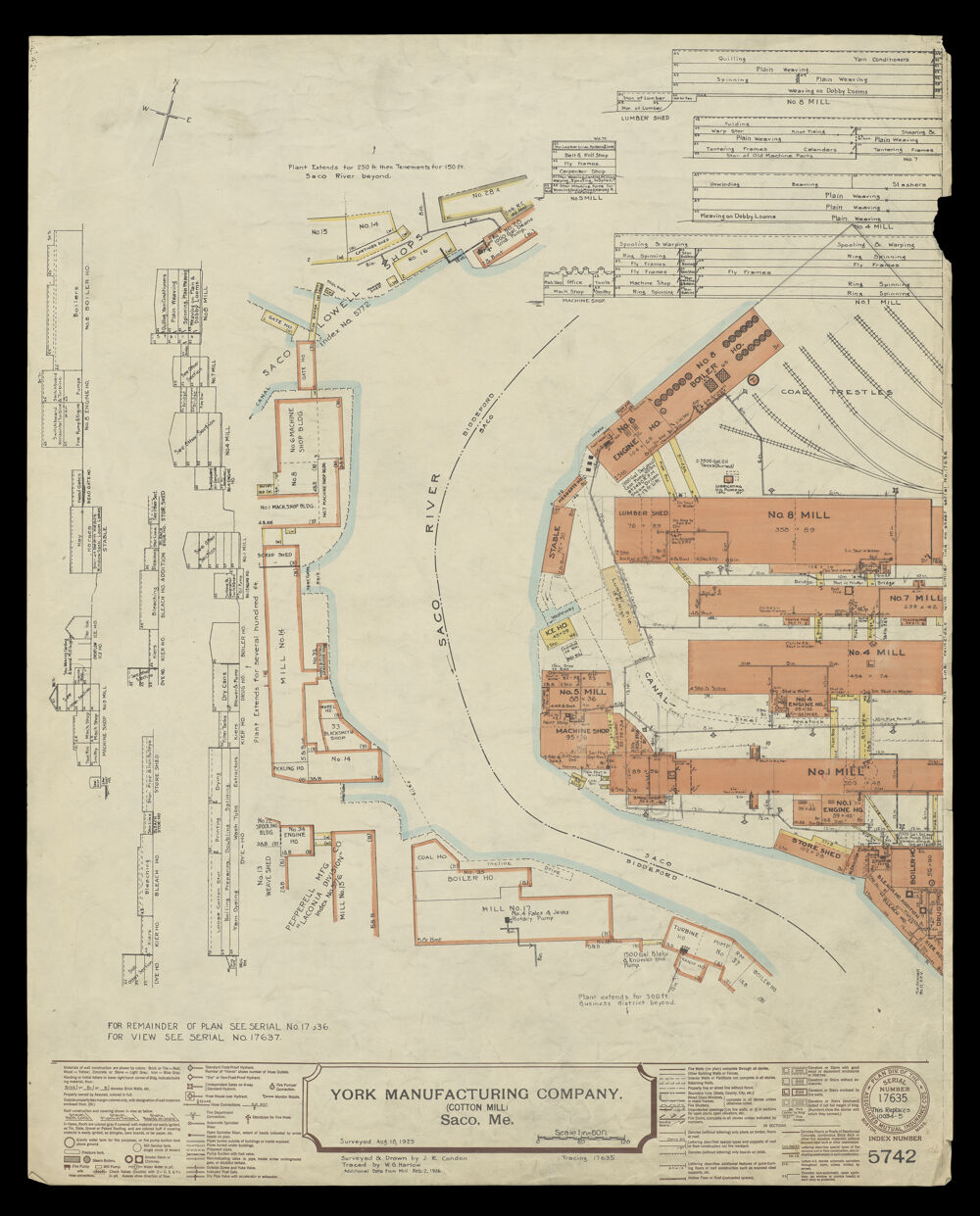
Click on image to see larger version.
The York Manufacturing Company was built on Saco Island in 1831, after an earlier textile mill had burned down. This survey and plan, completed on August 18, 1925, shows the cross sections and layout of the various mills and stores of the cotton mill. The survey also shows the location of “Pepperell Mfg. Co. Laconia Division” on the Biddeford side of the Saco River. York milled cotton goods, and by 1839 the company consisted of three mills and 1000 workers. In 1930, it was sold to New England Industries and became the York Division of Bates Manufacturing. In 1958, the factory shut down.
5. York Manufacturing Company (Cotton Mill), Saco, Me., (#17635, 17636), surveyed August 18, 1925
Associated Mutual Fire Insurance Companies, 1925
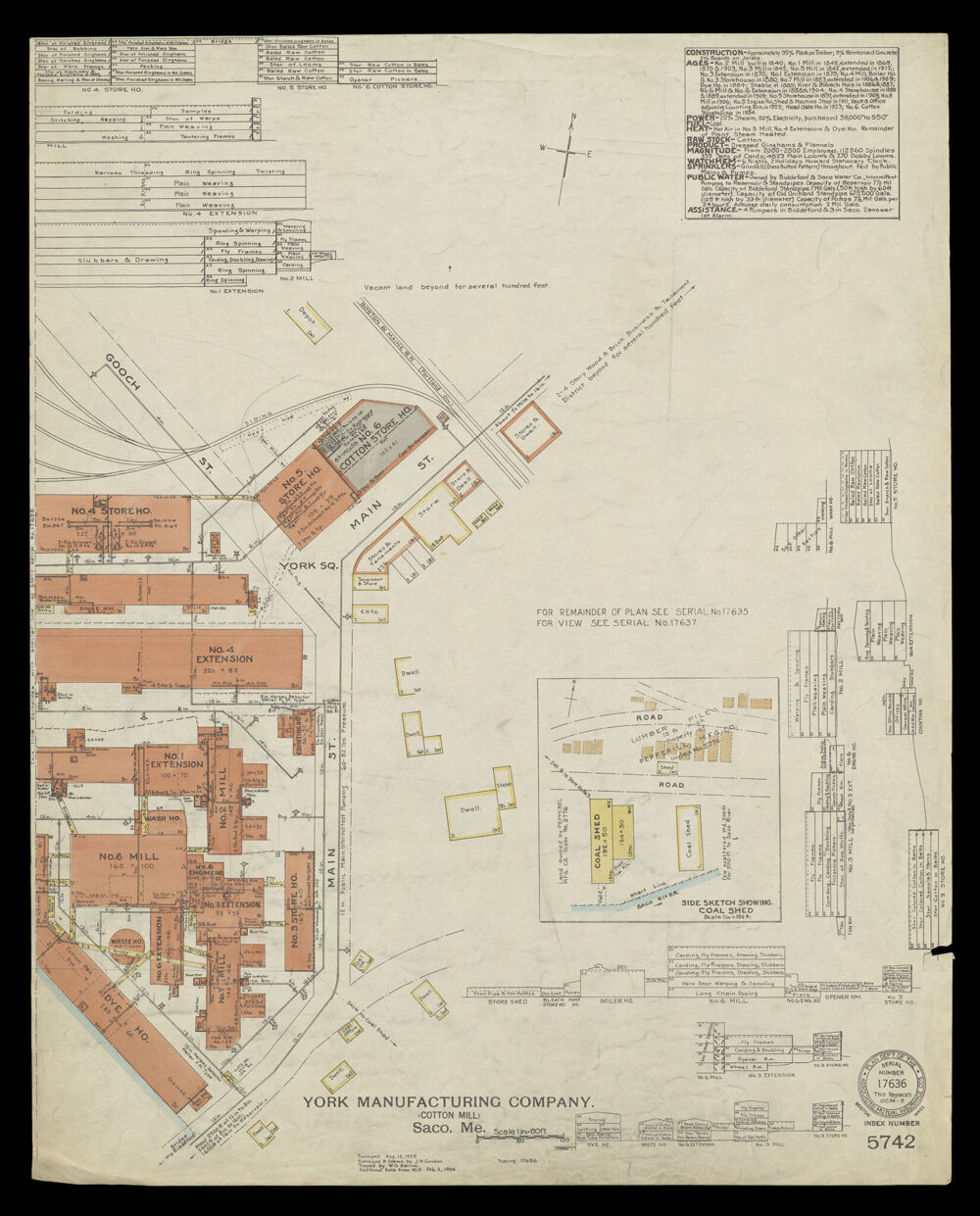
Click on image to see larger version.
The York Manufacturing Company was built on Saco Island in 1831, after an earlier textile mill had burned down. This survey and plan, completed on August 18, 1925, shows the cross sections and layout of the various mills and stores of the cotton mill. The survey also shows the location of “Pepperell Mfg. Co. Laconia Division” on the Biddeford side of the Saco River. York milled cotton goods, and by 1839 the company consisted of three mills and 1000 workers. In 1930, it was sold to New England Industries and became the York Division of Bates Manufacturing. In 1958, the factory shut down.
6. Village of Biddeford, 1835-1840
J.G. Garland, 1899
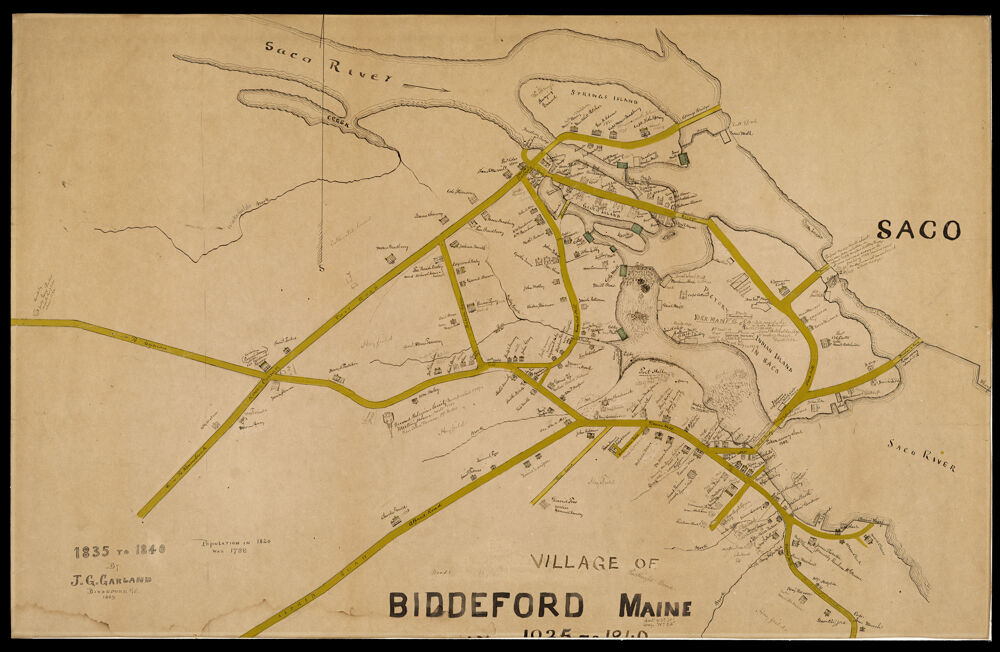
Click on image to see larger version.
Drawn in 1889, this manuscript “memory” map recreates the commercial and residential layout of the village of Biddeford between 1835 and 1840. James G. Garland (1827-1909), the author, included early mills such as the “old sawmill” which likely referred to the 18th century sawmill of Sir William Pepperell, one of the early property owners and developers in Biddeford. The map also shows “Factory” or “Indian Island,” where the York Manufacturing Company, along with its cotton factory buildings, was located. Garland also wrote notations about bridges, such as a bridge that connected to the mills which “was carried away” and then rebuilt as a toll bridge. He cites the house that belonged to an early merchant “Col. Cutts,” now the home of the founder of what became the Pepperell Manufacturing Company, Samuel Bachelder. The map also features residences and stores. Garland, an amateur local historian who was deeply invested in the history of the Revolutionary War era, was also connected to the mills. In 1881 he invented the Automatic Humidifier, which enabled people to work more comfortably in hot mill environments. He was also a longtime member of the New England Cotton Manufacturers Association.
7. [Bird’s Eye View of] Saco and Biddeford, Me
J. B. Bachelder, 1855
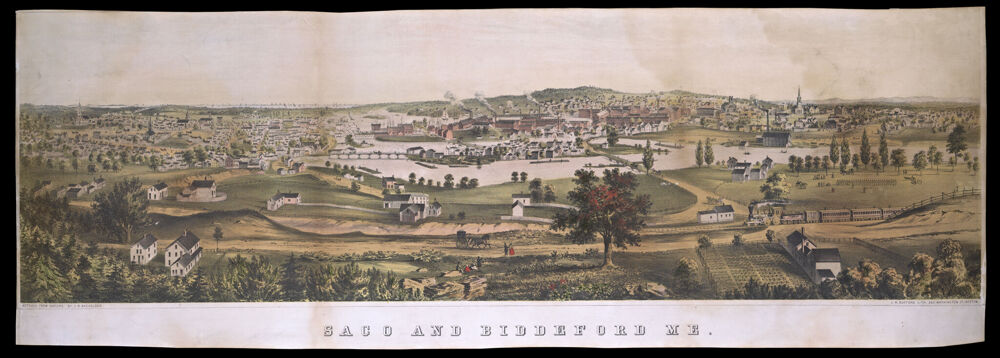
Click on image to see larger version.
This panoramic bird’s eye view of Saco and Biddeford, as the two towns looked in 1855, was “sketched from nature” by John Badger Bachelder (1825-1894), a portrait and landscape artist, photographer, and lithographer. While Bachelder became best known as the preeminent 19th century historian of the battle of Gettysburg following his publication of a panoramic view of the battlefield in the fall of 1863, his early lithographic landscapes of New England cities and towns were quite popular. This view (slightly cropped at the top by its original owner) was printed by Boston lithographer John H. Bufford (1810-1870), who produced city and landscape views, portraits, book illustrations and other genres.
Looking from the northeast, the view contrasts the pastoral scenery of Saco with the industrial mill complex across the Saco River in Biddeford. While churches and residential structures appear to be pervasive throughout the view, Bachelder’s central focus was the industrial buildings along the Saco River. In 1855, the same year Bachelder decided to publish his lithograph of Biddeford and Saco for his Album of New England Scenery series, Biddeford was incorporated as a city, a further testament to the industrial growth and expansion of the area due to the textile mills.
8. Map of the Villages of Saco and Biddeford, York County, Maine
Henry F. Walling, 1851
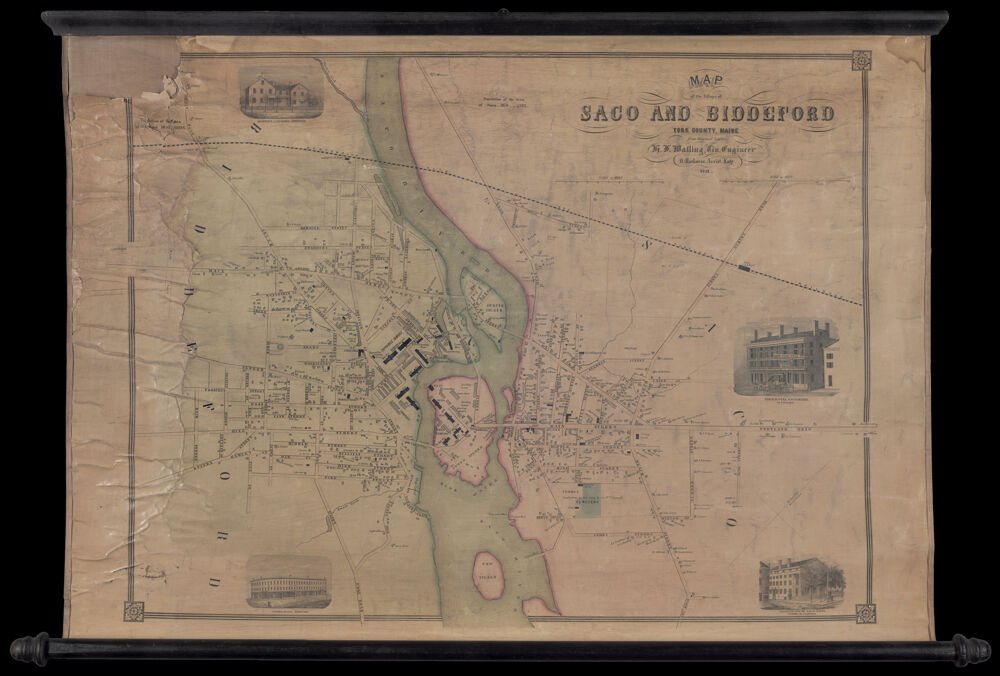
Click on image to see larger version.
Henry F. Walling’s (1825-1888) detailed wall map of Saco and Biddeford depicts the massive scale of the riverside mills and manufacturing complexes located on the Saco River in the middle of the 19th century. Included in Walling’s precise view are illustrations of prominent buildings, such as the Central Block in Biddeford (which is still there today); The Thornton House, part of Thornton Academy; and the York Hotel in Saco. Walling, originally from Providence, Rhode Island, was a civil engineer, surveyor, cartographer, and a major producer of precisely-rendered mid-19th century New England county and town maps that were displayed on walls in town offices, libraries, museums, schools, businesses and private residences. Sold by subscription, many Walling maps, like this one, showed the names of landowners, as well as churches and prominent businesses. He also indicates that according to the 1850 census, Biddeford had a population of 6,094 and Saco’s population numbered 5,707 residents, representing substantial growth in this region spurred on by the textile mill industry.